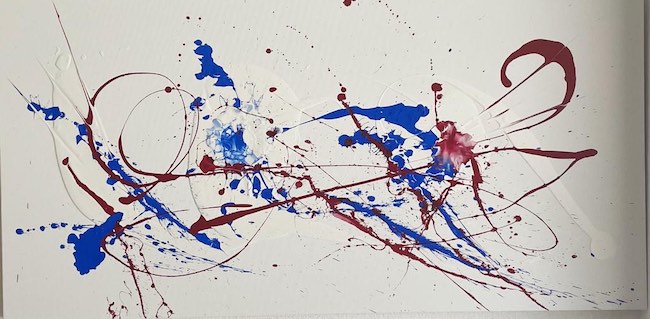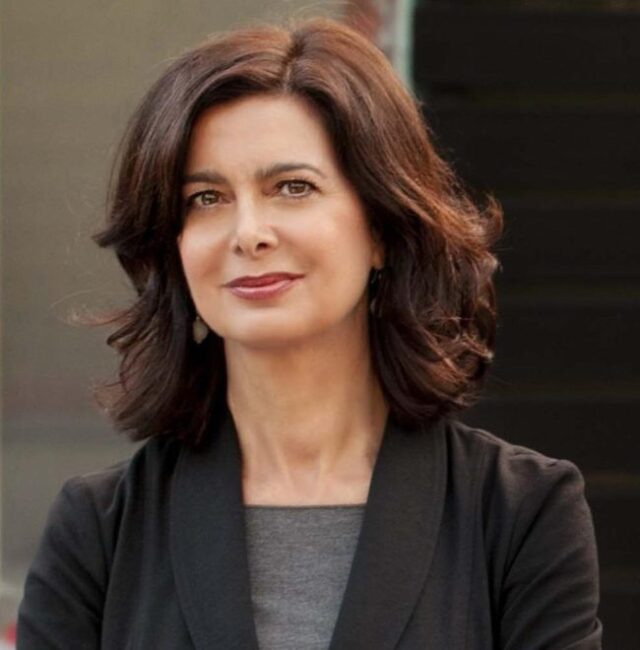La capacità comunicativa attraverso l’arte visiva si manifesta in maniera più chiara quando il creativo avverte l’esigenza di liberarsi da ogni legame con la figurazione, con tutto ciò che lo sguardo vede abitualmente intorno a sé e che costituisce un limite al libero fluire di sensazioni che non tollerano gabbie, schemi o confini perché tutto ciò di cui hanno bisogno è di armonizzarsi alle emozioni e poi fuoriuscire spontaneamente e impulsivamente. In questo tipo di approccio pittorico non esiste il controllo della mente se non in un momento successivo, quando la razionalità prende atto del risultato di quell’istinto generativo che si è poi manifestato sulla tela. Il protagonista di oggi fa sua una delle principali tecniche astrattiste per interpretare la realtà circostante, un pensiero, un ricordo e tutto ciò che colpisce e cattura la sua sensibilità.
Tutti i movimenti informali dei primi decenni del Novecento mostrarono una caratteristica comune, quella cioè di attuare una profonda spaccatura tra gesto plastico e mondo interiore del soggetto esecutore dell’opera; laddove l’Astrattismo Lirico di Vassily Kandinsky e le teorie del gruppo Der Blaue Reiter, di cui fu esponente Paul Klee, rinunciarono alla forma per privilegiare la percezione dell’interiorità, il Suprematismo e soprattutto il De Stijl invece vollero affermare la superiorità dell’atto creativo su qualunque tipo di soggettivismo, su qualsiasi sensazione dell’artista. Questo perché la guerra in Europa fece perdere i punti di riferimento e le certezze, alle persone come agli artisti; inoltre nel periodo post-bellico la società dell’epoca correva all’inseguimento del progresso e del materialismo, pertanto Piet Mondrian e Theo Van Doesburg decisero di elaborare uno stile grazie al quale mostrare l’importanza dell’arte fine a se stessa, pura proprio perché spogliata da ogni pulsione, ogni collegamento con una realtà circostante che stava andando verso una direzione sbagliata. Tuttavia l’eccessiva schematicità e l’approccio troppo mentale e razionale all’arte, di fatto provocarono un distacco da parte del pubblico che non si sentiva coinvolto emotivamente; malgrado l’Astrattismo Geometrico superò la rigidità delle forme quadrate e rettangolari e dei colori primari, mancava in ogni caso quel contatto con il mondo interiore che invece continuava a manifestarsi in maniera sempre più coinvolgente nel coevo Espressionismo, che contava sempre più estimatori. Questa impasse stilistica fu risolta da un movimento eccentrico, poliedrico, i cui esponenti dovettero combattere per essere accettati nel complesso e a volte statico circuito dell’arte di quell’epoca, siamo intorno agli anni Cinquanta del Ventesimo secolo, che prese il nome di Espressionismo Astratto e che coniugò la necessità di rinunciare alla forma conosciuta per consentire allo sguardo di non lasciarsi condizionare da qualcosa di osservabile azionando il meccanismo razionale, ma al tempo stesso di recuperare tutto quel mondo interiore escluso dai movimenti precedenti e che in realtà proprio nell’indefinitezza e nella non forma poteva trovare il sottofondo migliore per esprimersi liberamente. E fu esattamente la libertà il comune denominatore dell’Espressionismo Astratto, dove convertirono tecniche pittoriche completamente differenti le une dalle altre, come il Dripping, il Color Field, il Tachisme, la pittura segnica, il Minimalismo cromatico, ma tutte con il denominatore comune e l’intenzione di comunicare emozioni.
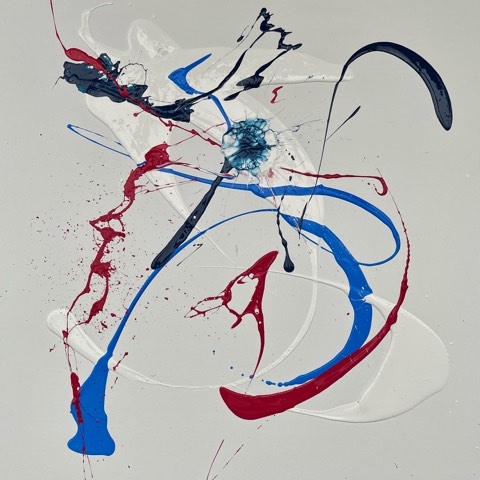
L’artista laziale Antonio Miralli crea una revisione contemporanea dell’Espressionismo Astratto, assumendo come caratteristica distintiva il Dripping che declina sulla base del proprio sentire, di una sensibilità empatica e orientata all’ascolto delle energie esterne derivante dal suo percorso di studi; laureato in Tecniche di Riabilitazione Psichiatrica comprende istintivamente l’importanza del processo liberatorio, quello in cui tutti i blocchi interiori riescono a liberarsi dalle proprie gabbie sciogliendo i nodi attraverso cui hanno trattenuto le sensazioni. Non solo, approfondendo l’Arteterapia ha scoperto quanto l’arte possa essere coadiuvante e risolutiva per chiunque abbia qualcosa da dire ma non riesca a farlo perché inibito da false credenze e convinzioni limitanti dentro cui rifugiarsi senza rendersi conto che di fatto quelle zone sicure divengono una prigione; così sceglie di intraprendere un percorso artistico a sua volta, perché trova proprio nella manifestazione creativa il suo canale energetico, quello attraverso il quale la compostezza lascia spazio all’impulsività, quello grazie a cui tutto ciò che spesso si sofferma nell’interno delle profondità, trova spazio e modo per fuoriuscire e raccontarsi indefinitamente sulla tela.
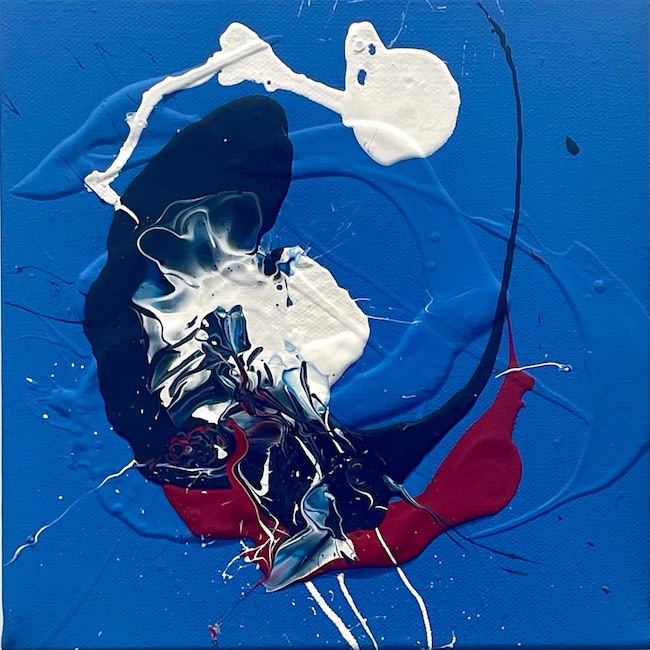
Il suo gesto spontaneo parte infatti dal mondo delle emozioni per propagarsi verso l’opera attraverso la scelta cromatica che più si conforma al suo modo di percepire e interpretare ciò che sente, optando spesso per la medesima tavolozza di colori primari, epurati dal giallo, tanto cara a Mondrian ma mostrando quanto quest’ultima possa essere difforme e divergente dalla rigidità che aveva contraddistinto il De Stijl, perché dalle opere di Antonio Miralli emerge l’intensità emozionale, l’immediatezza che appare come caos piuttosto che la determinazione dell’ordine. In qualche modo dunque, con il suo approccio pittorico, rompe gli schemi mostrando un volto diverso di quelle tonalità piene, decise, lanciate letteralmente sulla tela e a cui sembrano aggrapparsi per rivelare il concetto, il messaggio che l’artista desidera comunicare. È solo in un secondo momento che la mente è chiamata a prendere coscienza di ciò che è stato espresso, riflettendo su tutto ciò che attraverso il suo processo logico non avrebbe mai capito se non avesse lasciato spazio all’istinto creativo.
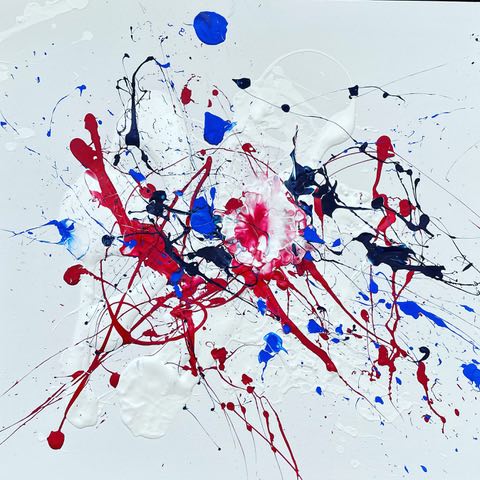
Così nell’opera Psiche il Dripping si trasforma in materia di pensiero, in idee, riflessioni, grovigli di considerazioni che troppo spesso generano confusione a causa dell’incapacità dell’essere umano di tirare fuori, uno a uno, quei fili logici che hanno bisogno di essere analizzati prima di cronicizzarsi e provocare confusione, insicurezze, paure, proprio perché non sono mai stati osservati nella loro singolarità. La base bianca del dipinto viene associata all’esigenza di luce laddove spesso si può nascondere l’ombra, dunque sembra quasi essere un’esortazione di Antonio Miralli a entrare in connessione con la parte silenziosa attuando quel processo di liberazione necessario alla crescita interiore e alla consapevolezza del sé.
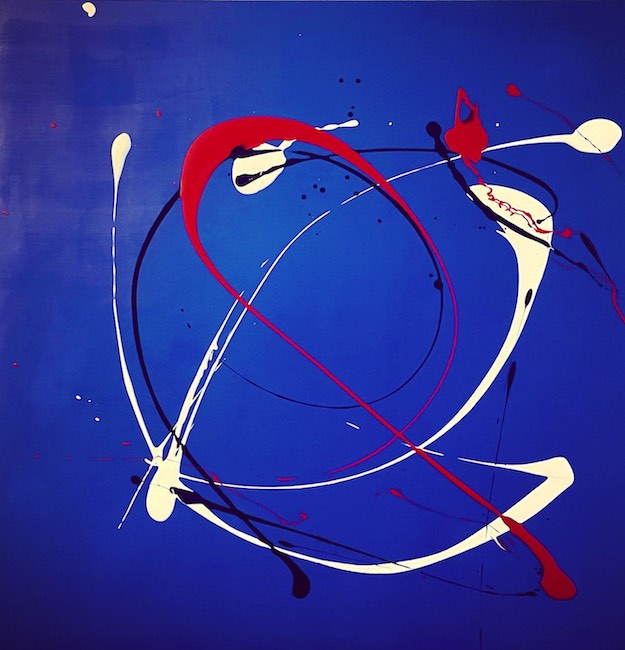
In Evoluzioni invece il colore dello sfondo è l’azzurro, da sempre associato all’universo delle sensazioni, di un intimismo funzionale a effettuare un percorso necessario all’anima per elevarsi, per approfondire la correlazione con le energie esterne ma anche con gli individui che più o meno casualmente entrano nel proprio raggio di azione, nel proprio cammino esistenziale, e che inevitabilmente generano quei meccanismi di causa ed effetto attraverso cui si innesca un cambiamento, un arricchimento a prescindere che la circostanza o l’evento che la loro presenza ha portato sia stato positivo o negativo sulla breve distanza. Qui il dripping costituisce le opportunità, le possibilità sono sempre funzionali alla crescita, sta solo all’uomo saperne cogliere gli insegnamenti prendendoli come punti di inizio di una nuova partenza.
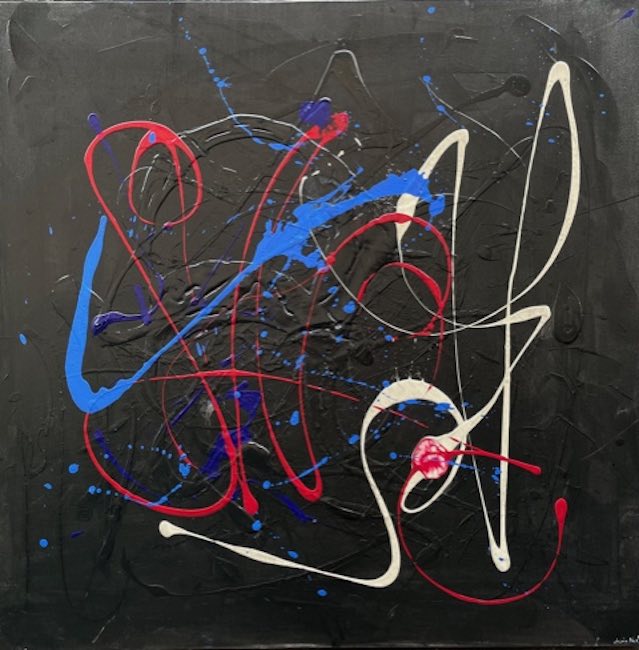
E poi ci sono i dipinti più legati a una circostanza particolare, un ricordo rimasto indelebile nella memoria di Antonio Miralli e che presentano un suggestivo sfondo nero su cui gli accadimenti si manifestano attraverso i colori, come fossero fotogrammi in sequenza ognuno dei quali si lega a una specifica sensazione che deve rimanere impressa nell’interiorità; è questo il caso della tela 20-12 dove il susseguirsi degli eventi sembra danzare su quel silenzio evocato dal nero e necessario per indurre la mente e l’interiorità a lasciar fuoriuscire un frammento importante del percorso di vita, essenziale per la traccia che ha lasciato e per la riflessione che ne è seguita.
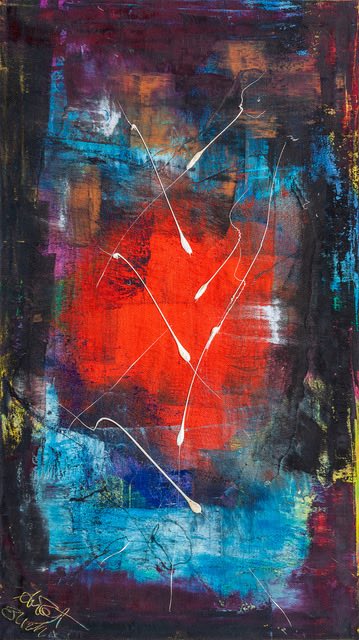
Anche nelle opere precedenti, quando la selezione cromatica era più ampia come nel dipinto Principio di indeterminazione, il Dripping è sempre stato un elemento distintivo delle opere di Miralli come se vi fosse all’interno della sua anima una predisposizione all’impellenza espressiva e al tempo stesso la necessità di evidenziare e dare maggiore consistenza ai punti focali, ai dettagli prevalenti sul resto della sensazione che permane intorno. L’indeterminazione in fondo costituisce tutto ciò che non può essere razionalizzato, a cui non può essere dato un senso se non arrendendosi all’impossibilità del controllo della mente.
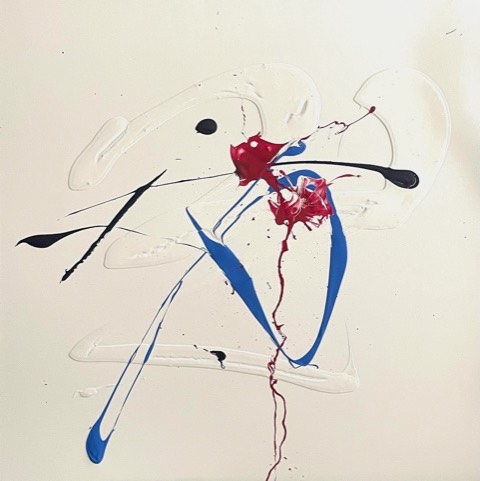
Antonio Miralli ha al suo attivo la partecipazione a molte mostre collettive nel Lazio, ha vinto un premio artistico nel 2019, ha partecipato a Vernice Art Fair di Forlì e ad Arte Padova, e ha esposto per tre edizioni come ospite alle mostre dell’Associazione Centro Pittori di via Margutta.
ANTONIO MIRALLI-CONTATTI
Email: mirallianto@gmail.com
Facebook: https://www.facebook.com/antonio.miralli
Instagram: https://www.instagram.com/antoniomiralli/
The manifold declinations of Dripping in Abstract Expressionism by Antonio Miralli
The ability to communicate through visual art manifests itself most clearly when the creative feels the need to free himself from all ties with figuration, with everything that the gaze habitually sees around him and that constitutes a limitation to the free flow of sensations that do not tolerate cages, schemes or boundaries because all they need is to harmonize with emotions and then spontaneously and impulsively drip out. In this kind of painterly approach, there is no mind control except at a later moment when rationality takes note of the result of that generative instinct which then manifested itself on the canvas. Today’s protagonist makes his own one of the main abstractionist techniques to interpret the surrounding reality, a thought, a memory, and anything else that strikes and captures his sensibility.
All informal movements of the first decades of the twentieth century showed a common characteristic, namely, that of enacting a profound split between plastic gesture and the inner world of the subject author of the artwork; where Vassily Kandinsky‘s Lyrical Abstractionism and the theories of the Der Blaue Reiter group, of which Paul Klee was an exponent, renounced form in order to privilege the perception of interiority, Suprematism and especially De Stijl on the other hand wanted to assert the superiority of the creative act over any kind of subjectivism, over any feeling of the artist. This was because the war in Europe made people as well as artists lose their points of reference and certainties; moreover, in the post-war period, the society of the time was running in pursuit of progress and materialism, so Piet Mondrian and Theo Van Doesburg decided to elaborate a style through which they could show the importance of art as an end in itself, pure precisely because it was stripped of any drive, any connection with a surrounding reality that was going in the wrong direction. However, the excessive schematicism and the excessively mental and rational approach to art actually caused a detachment on the part of the public, which did not feel emotionally involved; despite the fact that Geometric Abstractionism overcame the rigidity of square and rectangular shapes and primary colors, it still lacked that contact with the inner world that instead continued to manifest itself in an increasingly engaging way in the coeval Expressionism, which counted more and more admirers. This stylistic impasse was resolved by an eccentric, multifaceted movement, whose exponents had to fight to be accepted in the complex and sometimes static art circuit of that era -we are around the 1950s- which took the name of Abstract Expressionism and which combined the need to renounce the known form in order to allow the gaze not to be conditioned by something observable by operating the rational mechanism, but at the same time to recover all that inner world excluded by the previous movements and which in fact precisely in indefiniteness and non-form could find the best background to express itself freely.
And it was exactly freedom that was the common denominator of Abstract Expressionism, where they converted completely different painting techniques from each other, such as Dripping, Color Field, Tachisme, sign painting, chromatic Minimalism, but all with the common denominator and the intention to communicate emotions. Latium artist Antonio Miralli creates a contemporary revision of Abstract Expressionism, taking Dripping as a distinctive feature that he declines on the basis of his own feeling, of an empathic sensitivity and oriented to listening to external energies derived from his course of studies; graduated in Psychiatric Rehabilitation Techniques he instinctively understands the importance of the liberating process, the one in which all the inner blocks manage to free themselves from their cages by loosening the knots through which they have held back the sensations. Not only that, by delving into Art Therapy he discovered how art can be adjuvant and resolving for anyone who has something to say but is unable to do so because they are inhibited by false beliefs and limiting convictions within which they take refuge without realizing that in fact those safe zones become a prison; so he chooses to embark on an artistic path in turn, because he finds precisely in creative manifestation his energy channel, the one through which composure gives way to impulsiveness, the one thanks to which everything that often lingers within the depths finds space and a way to escape and tell itself indefinitely on the canvas. In fact, his spontaneous gesture starts from the world of emotions to propagate toward the artwork through the chromatic choice that most conforms to his way of perceiving and interpreting what he feels, often opting for the same palette of primary colors, purged of yellow, so dear to Mondrian but showing how much the latter can be dissimilar and divergent from the rigidity that had distinguished De Stijl, because from Antonio Miralli‘s paintings emerges emotional intensity, immediacy that appears as chaos rather than the determination of order. Somehow then, with his pictorial approach, he breaks the mold by showing a different face of those full, decisive tones, literally thrown on the canvas and to which they seem to cling to reveal the concept, the message that the artist wishes to communicate.
It is only at a later stage that the mind is called upon to become aware of what has been expressed, reflecting on all that through its logical process it would never have understood had it not left room for creative instinct. Thus in the artwork Psyche, Dripping is transformed into matter of thought, into ideas, reflections, tangles of considerations that too often generate confusion because of the inability of the human being to pull out, one by one, those logical threads that need to be analyzed before they become chronicled and cause confusion, insecurities, fears, precisely because they have never been observed in their singularity. The white base of the painting is associated with the need for light where shadow can often be hidden, so it almost seems to be an exhortation by Antonio Miralli to connect with the silent part by implementing that process of liberation necessary for inner growth and self-awareness. In Evolutions, on the other hand, the background color is light blue, which has always been associated with the universe of sensations, of an intimism functional to carry out a path necessary for the soul to elevate itself, to deepen the correlation with external energies but also with the individuals who more or less casually enter one’s range of action, in one’s existential path, and who inevitably generate those mechanisms of cause and effect through which a change, an enrichment is triggered regardless of whether the circumstance or the event that their presence has brought about has been positive or negative in the short distance. Here dripping constitutes opportunities, possibilities are always functional for growth, it is only up to man to know how to grasp the lessons by taking them as starting points for a new departure.
And then there are the paintings that are more related to a particular circumstance, a memory that has remained indelible in Antonio Miralli‘s memory and that present an evocative black background on which the happenings are manifested through colors, as if they were photograms in sequence each of which is linked to a specific sensation that must remain imprinted in the interiority; this is the case in the canvas 20-12 where the succession of events seems to dance on that silence evoked by the black and necessary to induce the mind and the interiority to let out an important fragment of life’s journey, essential for the trace it left and for the reflection that followed. Even in earlier paintings, when the chromatic selection was broader as in the painting Principle of Indeterminacy, Dripping has always been a distinctive element of Miralli’s artworks as if there was within his soul a predisposition to expressive impellence and at the same time a need to highlight and give greater consistency to the focal points, to the details prevailing over the rest of the sensation that lingers around. Indeterminacy basically constitutes everything that cannot be rationalized, which cannot be given meaning except by surrendering to the impossibility of mind control. Antonio Miralli has to his credit the participation in many group exhibitions in Lazio, won an art award in 2019, participated in Vernice Art Fair in Forlì and Arte Padova, and exhibited for three editions as a guest at the exhibitions of the Association of Centro Pittori di via Margutta.


